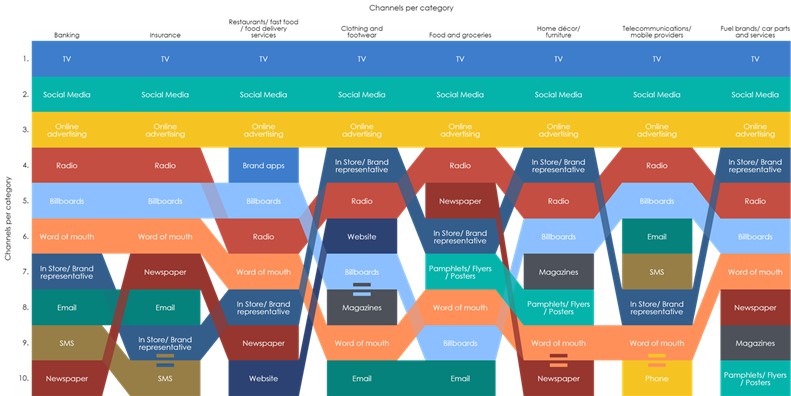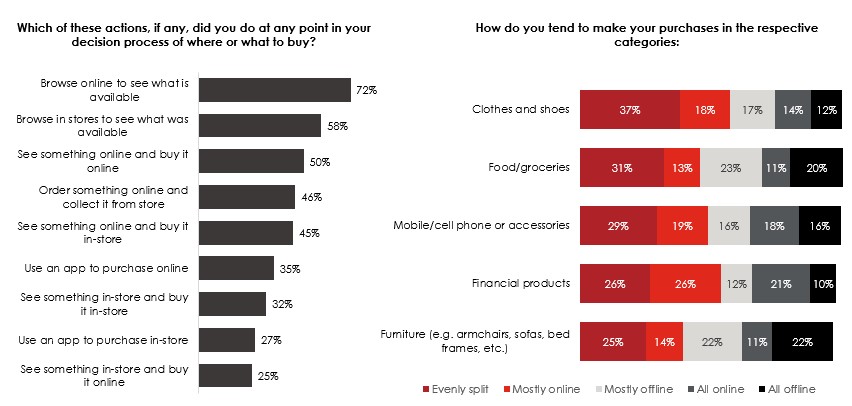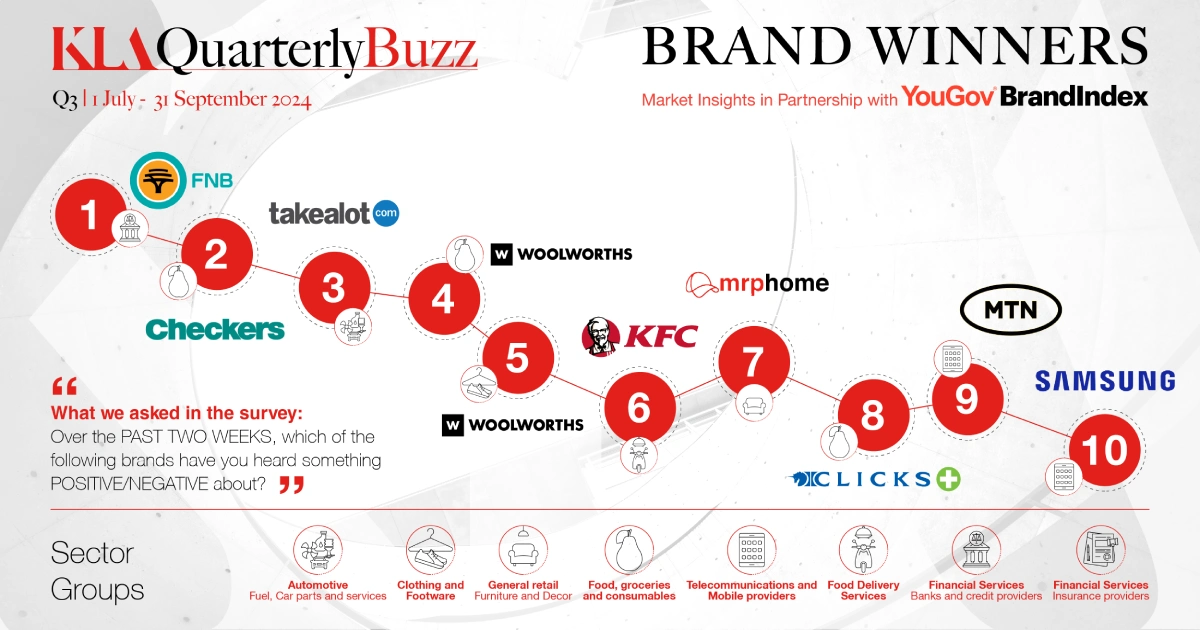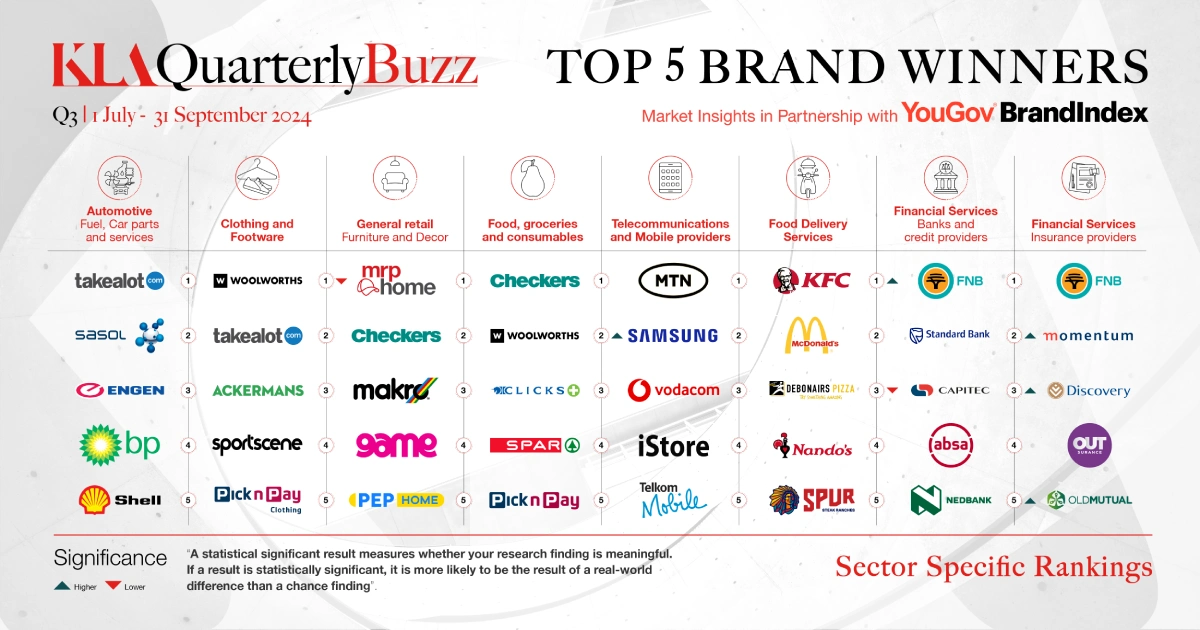Quarterly Buzz results for Q3 2024
The Quarterly Buzz leverages the YouGov BrandIndex tool, a dynamic platform that consistently evaluates public sentiment of over 200 brands in South Africa across eight categories. Through the BrandIndex tool, the top 10 performing brands across sectors are highlighted, with the top 5 brands respectively named within each category.
Employing a comprehensive framework of 16 metrics that span across the marketing funnel, the BrandIndex tools’ Buzz metric takes the spotlight. This metric evaluates consumer perception, gauging whether individuals have encountered positive or negative information about a brand in the preceding two weeks. Operating on a scale of +100 to -100, a net score is derived, offering a view of a brand’s performance relative to its competitors. These scores are accumulated over a three-month period, forming the basis for The Quarterly Buzz results, with the latest results being measured from 1 July to 30 September 2024.
The top performing brands across all sectors in Q3 of 2024 are:
After more than a year and a half of monitoring Buzz performance across sectors, the Food, Groceries and Consumables sector no longer dominates, with only three brands from this sector making the top 10 list in this quarter. This shift has resulted from a softening in Buzz performance for brands within this sector; while MTN and Samsung have gained traction, securing a spot as new entrants in this quarter.
The market continues to remain stable from the previous quarter, with two of the top 10 showing significant gains in Buzz. FNB demonstrates significant improvement in Awareness, Buzz and Consideration as well as quarter-on-quarter growth across all other metrics. These gains have elevated the brand by two rank positions, propelling it to first place for the first time since the launch of the Quarterly Buzz. Samsung also notes a significant increase in Buzz in the last quarter, securing a spot in the top 10, as a new entrant at number 10, for the first time. The brand experienced significant growth across 10 of the 16 metrics, particularly in the top-funnel reach metrics and all middle-funnel resonance metrics except for Impression, which also demonstrates a slight uptick, similarly to the other metrics that did not experience significant movements.
Meanwhile, Checkers, Woolworths Food, Mr Price Home, and Clicks experience a softening in Buzz performance, leading to a drop in rank position. In contrast, Takealot (Automotive sector) and KFC, both note marginal improvement, each gaining one rank position.
When delving deeper, sector specific results for Q3 of 2024 is as follows:
Sector-specific results for Q3 of 2024 highlight a relatively stable top five within each sector, with a few new entrants across the eight sectors tracked, notably Shell, PnP Clothing, Pick n Pay, Momentum, and Old Mutual in their respective categories.
In the latest report, specific brand’s performance reflects dynamic trends in the South African market.
FNB: Driving inclusivity and accessibility through innovation
FNB has consistently appeared in the top 10 since the launch of the Quarterly Buzz – its ongoing efforts to innovate and focus on putting customers at the heart of its developments has helped the brand maintain a strong presence in the market. In the last quarter, FNB confirmed that its promotion for licence disc renewals at R69 would continue until December 2024, and it introduced a special offer for EasyPayU account holders, allowing them to purchase a loaf of bread for just 99 cents. Additionally, the bank announced plans to roll out a contactless payment system at toll plazas over the next 12 months.
Although the brand experienced a payday outage in August, the overall positive Buzz has outweighed this issue, helping FNB secure the top position. Notably, the bank has been in the spotlight for its sponsorship of the ‘App of the Year’ ecosystem, Africa’s leading app development competition and technology challenge, aligning to the brands’ strategic focus on innovation. In line with this, the brand has earned recognition as the best digital bank. FNB has also focused on serving its high-net-worth customers with integrated advisory services, tailored to support their financial journeys and address their diverse needs. This inclusive approach focusing on customers’ needs has solidified the brand’s position as a leader in this quarter.
MTN: Commitment to connectivity
While MTN’s Buzz performance remains stable, 14 of the 16 metrics show marginal quarter-on-quarter improvement. With the Telecommunications sector at the forefront of the technological evolution, MTN continues to stay ahead of technological advancements and improved connectivity. Recent initiatives include the deployment of eight new towers in KZN, benefiting over 600,000 people. In collaboration with Accenture, MTN is testing an open radio access network (ORAN) solution to enhance customer experience and reduce costs. The brand is also working with ZTE on Africa’s first 5G marine coverage to support the ocean economy and protect marine ecosystems, with the goal of revolutionising maritime connectivity.
Additionally, MTN has supported several community initiatives, such as the Y’ello Care Bus, a mobile tech library that brings educational resources to rural schools, helping bridge the digital divide. The brand also invested R14m in a digital programme, providing 100 unemployed youth with the opportunity to participate in a 12-month accredited training course, preparing them for careers in the IT sector.
Samsung: Immersing consumers in brand innovation
Samsung, a new entrant, has noted significant growth in the last quarter, resulting in the brand featuring at number 10. With AI emerging as a key growth driver across sectors, the brand launched its Bespoke AI range of home appliances that are energy efficient and sustainable, with its ability to integrate into a smart home. This also includes a partnership with Unilever on the co-creation of the future of laundry, using consumer technology to fuel innovation and growth to this sector. Building on this rise of AI and technology, Samsung also launched an immersive experiential space for a limited time, allowing consumers to explore the brand’s latest innovations firsthand. Additionally, the brand expanded its portfolio with the introduction of smart rings and enhanced folding smartphones. In leveraging AI and leading on innovation, the brand offers consumers the ability to be a part of the evolving technological landscape, through sustainable products that help improve user lives.
Advertising: Growing need to balance omnichannel approaches
It is well acknowledged that advertising plays a significant role in creating brand awareness and driving consumer engagement. However, with the fast-paced evolution of AI and technology, the way brands leverage this to create and optimise, particularly for digital channels, forms a critical role in marketing strategy. With this, consumers are also looking for speed and content that gets to the point quickly, resulting in a boost of shorter advertising content. In addition, the need for authenticity and trust building that drives a deeper connection is growing in importance, particularly with the rise of the Gen Z, a segment that is more socially, financially, and environmentally conscious than ever. As a result, there is a growing need to bridge the divide between the real and digital world to create experiences that not only meet functional needs but also drives emotional connection.
Despite the fundamental shifts in how people consume media, and beyond the delicate balance required between traditional and digital media forms, long-standing principles still apply. Advertising that is relevant, engaging, and distinctive allows brands to stand out. However, with trends of declining mental availability continuing, consistent and single-minded messaging is increasingly important.
KLA tracks channels that are most recalled across sectors. We spoke to a nationally representative sample of South Africa to understand which channels remain top of mind for this quarter.

Source: KLA YourView Consumer Panel, Omnibus, 1 July – 30 September 2024 n=800
TV and digital advertising (including online ads and social media) remain the dominant channels most recalled across all sectors. However, TV has shown a softening in performance across sectors, while social media has gained more prominence this quarter. There are also notable variations in how these channels drive brand awareness within specific sectors. For instance, TV continues to be particularly influential in banking and insurance, as per the previous quarter, while SMS ranks #9 and in-store advertising surpasses newspapers in being more influential within the banking sector.
In the fast-food sector, brand apps remain a key channel for recall, holding the fourth position – highest among all sectors – while newspapers and websites have emerged as new influencers. Interestingly, in-store advertising and brand representatives, previously ranked strongly in the clothing sector, has gained prominence featuring in fourth position for Clothing, Home Décor and the Automotive sector in this quarter. Billboards and emails have lost some relevance in clothing, with websites and word of mouth (WOM) now appearing in the top 10 (sixth and ninth positions, respectively). In the Home Décor sector, magazines have dropped in rank, overtaken by in-store and billboard ads, while WOM has entered the top 10 at #9. The Food and Grocery sector remains stable, while the Telecom and Automotive sectors note SMS and magazines as new channels, respectively.
Overall, websites have become a new top 10 feature, especially for quick-service restaurants (QSR) and clothing, driven by the rise of online shopping. WOM is now a top 10 feature across all sectors, up from only 6 sectors previously. The rise in prominence of in-store and WOM underscores the growing importance of an omnichannel approach to brand recall, with a focus on personal connection driving recommendation and usage.
The power of the customer: Long term brand building
Consumer behaviour is influenced by a variety of factors, including the rapid evolution of technology and AI, as well as broader macro-economic conditions such as the rising cost of living. Some key trends we’ve observed in consumer behaviour include:
- The rise of the ‘hermit’ consumer, who seeks more solitude and fewer social interactions.
- A growing focus on affordability, with consumers prioritising cost-effective options.
- Increased emphasis on sustainability and eco-conscious purchasing decisions
- A more recent shift toward value-for-money purchases, where consumers weigh the trade-off between quality and affordability.
Globally, there is a power shift: from brands to the consumer. Consumers have easy access to a wealth of information, allowing them to make informed decisions and take control of their interactions with brands, owing to enhancements in technology and increased access to digital tools. These shifts, driven by an increasingly demanding, detached, and empowered consumer, force brands to rethink their approach.
This empowered customer creates a dynamic environment where brand loyalty wanes, making it clear that a one-size-fits-all approach no longer works. Today, customer experience, and brand trust are key drivers of preference, underscoring the need for personalised and responsive strategies to meet evolving customer expectations. This results in brands needing to proactively monitor customer needs and brand performance.
This aligns to VML’s ‘The Future Shopper 2024’ report, which highlights the slowing down of online shopping and preference for a more balanced shopping experience through physical stores. This is reiterated in the KLA YouGov Profiles data:

Source: YouGov Profiles, 2024-11-03, n=5336
However, the resurgence of physical shopping experiences, exacerbated by technology, is pushing brands to evolve this experience to be immersive, innovative, seamless, and convenient, similar to the seamlessness required in omnichannel marketing approaches. The customer journey is now more interconnected with brand touchpoints than ever before. This is reinforced by the Financial Mail who speaks to the need for memorable moments that create an emotional experience, with at least 50% of consumers willing to pay more for a better experience – even in a cash-strapped economy.
Therefore, while acquisition strategies are vital in any brand strategy, focusing on driving brand growth through retention activities is critical in this shifting environment. To do this effectively, we need to be thinking of how we leverage the big data available to us and monitor ongoing performance to analyse patterns and behaviours that allow brands to focus on making consumers feel like they matter and to be proactive as opposed to reactive.





